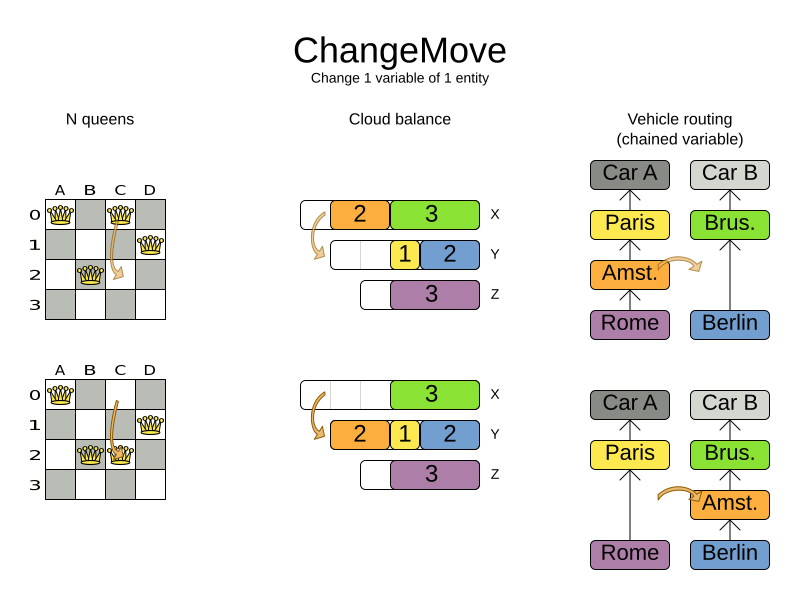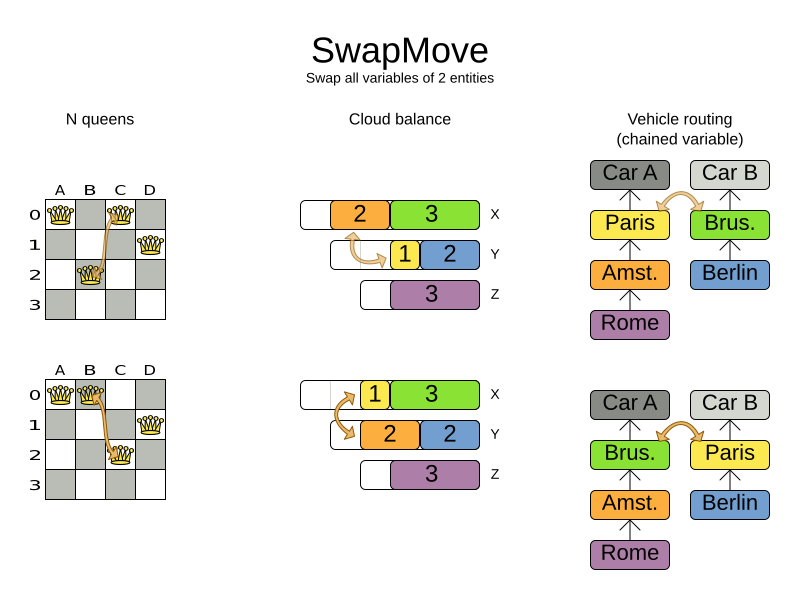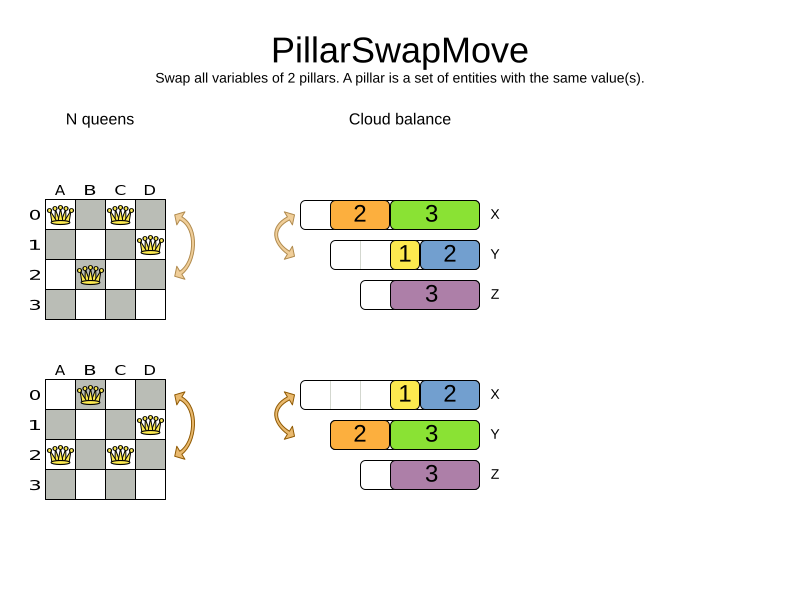Move Selector reference
This chapter describes the move selectors that can be used to select moves for the optimization algorithms. For a general introduction to move selectors, see Move and neighborhood selection.
The following MoveSelector implementations are available out of the box:
| Name | Description |
|---|---|
Change 1 entity’s variable |
|
Swap all variables of 2 entities |
|
Change a set of entities with the same value |
|
Swap 2 sets of entities with the same values |
|
Take a subset of entities, uninitialize them and run a construction heuristic to put them back |
|
Move a list element to a different index or to another entity’s list variable |
|
Swap 2 list elements |
|
Move a subList from one position to another |
|
Swap 2 subLists |
|
Select an entity, remove k edges from its list variable, add k new edges from the removed endpoints |
|
Take a subset of values, remove them from their lists, and run a construction heuristic to recreate the lists |
|
Swap 2 tails chains |
|
Cut a subchain and paste it into another chain |
|
Swap 2 subchains |
1. Move selectors for basic variables
These moves are applicable to planning variables that aren’t part of a list or a chain, also called basic variables.
1.1. ChangeMoveSelector
For one planning variable, the ChangeMove selects one planning entity and one planning value and assigns the entity’s variable to that value.

Simplest configuration:
<changeMoveSelector/>If there are multiple entity classes or multiple planning variables for one entity class,
a simple configuration will automatically unfold into
an union
of ChangeMove selectors for every planning variable.
Advanced configuration:
<changeMoveSelector>
... <!-- Normal selector properties -->
<entitySelector>
<entityClass>...Lecture</entityClass>
...
</entitySelector>
<valueSelector variableName="room">
...
</valueSelector>
</changeMoveSelector>A ChangeMove is the finest grained move.
|
Almost every |
This move selector only supports phase or solver caching if it doesn’t apply on a chained variable.
1.2. SwapMoveSelector
The SwapMove selects two different planning entities and swaps the planning values of all their planning variables.

Although a SwapMove on a single variable is essentially just two ChangeMoves,
it’s often the winning step in cases that the first of the two ChangeMoves would not win
because it leaves the solution in a state with broken hard constraints.
For example: swapping the room of two lectures doesn’t bring the solution in an intermediate state where both lectures are in the same room which breaks a hard constraint.
Simplest configuration:
<swapMoveSelector/>If there are multiple entity classes, a simple configuration will automatically unfold
into an union
of SwapMove selectors for every entity class.
Advanced configuration:
<swapMoveSelector>
... <!-- Normal selector properties -->
<entitySelector>
<entityClass>...Lecture</entityClass>
...
</entitySelector>
<secondaryEntitySelector>
<entityClass>...Lecture</entityClass>
...
</secondaryEntitySelector>
<variableNameIncludes>
<variableNameInclude>room</variableNameInclude>
<variableNameInclude>...</variableNameInclude>
</variableNameIncludes>
</swapMoveSelector>The secondaryEntitySelector is rarely needed: if it is not specified, entities from the same entitySelector are swapped.
If one or more variableNameInclude properties are specified, not all planning variables will be swapped, but only those specified.
This move selector only supports phase or solver caching if it doesn’t apply on any chained variables.
1.3. Pillar-based move selectors
A pillar is a set of planning entities which have the same planning value(s) for their planning variable(s).
1.3.1. PillarChangeMoveSelector
The PillarChangeMove selects one entity pillar (or subset of those) and changes the value of one variable (which is the same for all entities) to another value.

In the example above, queen A and C have the same value (row 0) and are moved to row 2. Also the yellow and blue process have the same value (computer Y) and are moved to computer X.
Simplest configuration:
<pillarChangeMoveSelector/>Advanced configuration:
<pillarChangeMoveSelector>
<subPillarType>SEQUENCE</subPillarType>
<subPillarSequenceComparatorClass>...ShiftComparator</subPillarSequenceComparatorClass>
... <!-- Normal selector properties -->
<pillarSelector>
<entitySelector>
<entityClass>...Shift</entityClass>
...
</entitySelector>
<minimumSubPillarSize>1</minimumSubPillarSize>
<maximumSubPillarSize>1000</maximumSubPillarSize>
</pillarSelector>
<valueSelector variableName="employee">
...
</valueSelector>
</pillarChangeMoveSelector>For a description of subPillarType and related properties, please refer to Sub-pillars.
The other properties are explained in changeMoveSelector. This move selector doesn’t support phase or solver caching and step caching scales badly memory wise.
1.3.2. PillarSwapMoveSelector
The PillarSwapMove selects two different entity pillars and swaps the values of all their variables for all their entities.

Simplest configuration:
<pillarSwapMoveSelector/>Advanced configuration:
<pillarSwapMoveSelector>
<subPillarType>SEQUENCE</subPillarType>
<subPillarSequenceComparatorClass>...ShiftComparator</subPillarSequenceComparatorClass>
... <!-- Normal selector properties -->
<pillarSelector>
<entitySelector>
<entityClass>...Shift</entityClass>
...
</entitySelector>
<minimumSubPillarSize>1</minimumSubPillarSize>
<maximumSubPillarSize>1000</maximumSubPillarSize>
</pillarSelector>
<secondaryPillarSelector>
<entitySelector>
...
</entitySelector>
...
</secondaryPillarSelector>
<variableNameIncludes>
<variableNameInclude>employee</variableNameInclude>
<variableNameInclude>...</variableNameInclude>
</variableNameIncludes>
</pillarSwapMoveSelector>For a description of subPillarType and related properties, please refer to sub-pillars.
The secondaryPillarSelector is rarely needed: if it is not specified, entities from the same pillarSelector are swapped.
The other properties are explained in swapMoveSelector and pillarChangeMoveSelector. This move selector doesn’t support phase or solver caching and step caching scales badly memory wise.
1.3.3. Sub-pillars
A sub-pillar is a subset of entities that share the same value(s) for their variable(s).
For example if queen A, B, C and D are all located on row 0, they’re a pillar and [A, D] is one of the many sub-pillars.
There are several ways how sub-pillars can be selected by the subPillarType property:
-
ALL(default) selects all possible sub-pillars. -
SEQUENCElimits selection of sub-pillars to Sequential sub-pillars. -
NONEnever selects any sub-pillars.
If sub-pillars are enabled, the pillar itself is also included and the properties minimumSubPillarSize (defaults to 1) and maximumSubPillarSize (defaults to infinity) limit the size of the selected (sub) pillar.
|
The number of sub-pillars of a pillar is exponential to the size of the pillar.
For example a pillar of size 32 has |
Sequential sub-pillars
sub-pillars can be sorted with a Comparator. A sequential sub-pillar is a continuous subset of its sorted base pillar.
For example, if an employee has shifts on Monday (M), Tuesday (T), and Wednesday (W),
they’re a pillar and only the following are its sequential sub-pillars: [M], [T], [W], [M, T], [T, W], [M, T, W].
But [M, W] is not a sub-pillar in this case, as there is a gap on Tuesday.
Sequential sub-pillars apply to both Pillar change move and Pillar swap move. A minimal configuration looks like this:
<pillar...MoveSelector>
<subPillarType>SEQUENCE</subPillarType>
</pillar...MoveSelector>In this case, the entity being operated on must implement the Comparable interface. The size of sub-pillars will not be limited in any way.
An advanced configuration looks like this:
<pillar...MoveSelector>
...
<subPillarType>SEQUENCE</subPillarType>
<subPillarSequenceComparatorClass>...ShiftComparator</subPillarSequenceComparatorClass>
<pillarSelector>
...
<minimumSubPillarSize>1</minimumSubPillarSize>
<maximumSubPillarSize>1000</maximumSubPillarSize>
</pillarSelector>
...
</pillar...MoveSelector>In this case, the entity being operated on needn’t be Comparable.
The given subPillarSequenceComparatorClass is used to establish the sequence instead.
Also, the size of the sub-pillars is limited in length of up to 1000 entities.
1.4. RuinRecreateMoveSelector
The RuinRecreateMove selects a subset of entities and sets their values to null,
effectively unassigning them.
Then it runs a construction heuristic to assign them again.
If unassigned values are allowed,
it may leave them unassigned.
This coarse-grained move is useful to help the solver to escape from a local optimum. It allows the solver to effectively "undo" a number of earlier decisions in one step, opening up a new part of the solution space.
|
If nearby selection is enabled,
the |
This move is not enabled by default.
To enable it, add the following to the localSearch section of the solver configuration:
<ruinRecreateMoveSelector/>|
The default values have been determined by extensive benchmarking. That said, the optimal values may vary depending on the problem, available solving time, and dataset at hand. We recommend that you experiment with these values to find the best fit for your problem. |
Advanced configuration:
<ruinRecreateMoveSelector>
<minimumRuinedCount>5</minimumRuinedCount>
<maximumRuinedCount>20</maximumRuinedCount>
<entitySelector>
<entityClass>...Lecture</entityClass>
...
</entitySelector>
<variableName>room</variableName>
</ruinRecreateMoveSelector>The minimumRuinedCount and maximumRuinedCount properties limit the number of entities that are unassigned.
The default values are 5 and 20 respectively, but for large datasets,
it may prove beneficial to increase these values.
The entitySelector property specifies which entity should be selected, allowing its values to be ruined and recreated.
In a model with multiple entities, this property is required,
or the solver will fail because it cannot automatically deduce the entity.
When there are multiple basic variables defined in the model, the solver cannot automatically select one of them.
The property variableName allows you to specify which variable will be used by the move generator.
|
|
Since the RuinRecreateMove is a coarse-grained move,
it is expensive and can slow the solver down significantly.
However, the default local search configuration will attempt to run it at the same frequency
as the other fine-grained moves.
For that reason, we recommend that you use probabilistic selection
to control the frequency of this move:
<unionMoveSelector>
<unionMoveSelector>
<fixedProbabilityWeight>100.0</fixedProbabilityWeight>
<changeMoveSelector/>
<swapMoveSelector/>
</unionMoveSelector>
<ruinRecreateMoveSelector>
<fixedProbabilityWeight>1.0</fixedProbabilityWeight>
</ruinRecreateMoveSelector>
</unionMoveSelector>The above configuration will run the RuinRecreateMove once for every 100 fine-grained moves.
As always, benchmarking is recommended to find the optimal value for your use case.
2. Move selectors for list variables
These moves are applicable to list planning variables.
2.1. ListChangeMoveSelector
The ListChangeMoveSelector selects an element from a list variable’s value range and moves it from its current position to a new one.
Simplest configuration:
<listChangeMoveSelector/>Advanced configuration:
<listChangeMoveSelector>
... <!-- Normal selector properties -->
<valueSelector id="valueSelector1">
...
</valueSelector>
<destinationSelector>
<entitySelector>
...
</entitySelector>
<valueSelector>
...
</valueSelector>
</destinationSelector>
</listChangeMoveSelector>2.2. ListSwapMoveSelector
The ListSwapMoveSelector selects two elements from the same list variable value range and swaps their positions.
Simplest configuration:
<listSwapMoveSelector/>2.3. SubListChangeMoveSelector
A subList is a sequence of elements in a specific entity’s list variable between fromIndex and toIndex.
The SubListChangeMoveSelector selects a source subList by selecting a source entity and the source subList’s fromIndex and toIndex.
Then it selects a destination entity and a destinationIndex in the destination entity’s list variable.
Selecting these parameters results in a SubListChangeMove that removes the source subList elements from the source entity and adds them to the destination entity’s list variable at the destinationIndex.
Simplest configuration:
<subListChangeMoveSelector/>Advanced configuration:
<subListChangeMoveSelector>
... <!-- Normal selector properties -->
<selectReversingMoveToo>true</selectReversingMoveToo>
<subListSelector id="subListSelector1">
<valueSelector>
...
</valueSelector>
<minimumSubListSize>2</minimumSubListSize>
<maximumSubListSize>6</maximumSubListSize>
</subListSelector>
</subListChangeMoveSelector>2.4. SubListSwapMoveSelector
A subList is a sequence of elements in a specific entity’s list variable between fromIndex and toIndex.
The SubListSwapMoveSelector selects a left subList by selecting a left entity and the left subList’s fromIndex and toIndex.
Then it selects a right subList by selecting a right entity and the right subList’s fromIndex and toIndex.
Selecting these parameters results in a SubListSwapMove that swaps the right and left subLists between right and left entities.
Simplest configuration:
<subListSwapMoveSelector/>Advanced configuration:
<subListSwapMoveSelector>
... <!-- Normal selector properties -->
<selectReversingMoveToo>true</selectReversingMoveToo>
<subListSelector id="subListSelector1">
<valueSelector>
...
</valueSelector>
<minimumSubListSize>2</minimumSubListSize>
<maximumSubListSize>6</maximumSubListSize>
</subListSelector>
</subListSwapMoveSelector>2.5. KOptListMoveSelector
The KOptListMoveSelector considers the list variable to be
a graph whose edges are the consecutive elements of the list
(with the last element being consecutive to the first element).
A KOptListMove selects an entity, remove k edges from its list variable, and add k new edges from the removed edges' endpoints.
This move may reverse segments of the graph.

Simplest configuration:
<kOptListMoveSelector/>Advanced configuration:
<kOptListMoveSelector>
... <!-- Normal selector properties -->
<minimumK>2</minimumK>
<maximumK>4</maximumK>
</kOptListMoveSelector>2.6. ListRuinRecreateMoveSelector
The ListRuinRecreateMove selects a subset of values, and removes them from their list variables.
Then it runs a construction heuristic to assign them again.
If unassigned values are allowed,
it may leave them unassigned.
This coarse-grained move is useful to help the solver to escape from a local optimum. It allows the solver to effectively "undo" a number of earlier decisions in one step, opening up a new part of the solution space.
|
If nearby selection is enabled,
the |
This move is not enabled by default.
To enable it, add the following to the localSearch section of the solver configuration:
<listRuinRecreateMoveSelector/>|
The default values have been determined by extensive benchmarking. That said, the optimal values may vary depending on the problem, available solving time, and dataset at hand. We recommend that you experiment with these values to find the best fit for your problem. |
Advanced configuration:
<listRuinRecreateMoveSelector>
<minimumRuinedCount>5</minimumRuinedCount>
<maximumRuinedCount>40</maximumRuinedCount>
</listRuinRecreateMoveSelector>The minimumRuinedCount and maximumRuinedCount properties limit the number of values that are unassigned.
The default values are 5 and 20 respectively, but for large datasets,
it may prove beneficial to increase these values.
|
|
Since the ListRuinRecreateMove is a coarse-grained move,
it is expensive and can slow the solver down significantly.
However, the default local search configuration will attempt to run it at the same frequency
as the other fine-grained moves.
For that reason, we recommend that you use probabilistic selection
to control the frequency of this move:
<unionMoveSelector>
<unionMoveSelector>
<fixedProbabilityWeight>100.0</fixedProbabilityWeight>
<listChangeMoveSelector/>
<listSwapMoveSelector/>
</unionMoveSelector>
<listRuinRecreateMoveSelector>
<fixedProbabilityWeight>1.0</fixedProbabilityWeight>
</listRuinRecreateMoveSelector>
</unionMoveSelector>The above configuration will run the ListRuinRecreateMove once for every 100 fine-grained moves.
As always, benchmarking is recommended to find the optimal value for your use case.
3. Move selectors for chained variables
These moves are applicable to chained planning variable.
3.1. TailChainSwapMoveSelector or 2-opt
A tailChain is a set of planning entities with a chained planning variable which form the last part of a chain.
The tailChainSwapMove selects a tail chain and swaps it with the tail chain of another planning value (in a different or the same anchor chain). If the targeted planning value, doesn’t have a tail chain, it swaps with nothing (resulting in a change like move). If it occurs within the same anchor chain, a partial chain reverse occurs.
In academic papers, this is often called a 2-opt move.
Simplest configuration:
<tailChainSwapMoveSelector/>Advanced configuration:
<tailChainSwapMoveSelector>
... <!-- Normal selector properties -->
<entitySelector>
<entityClass>...Customer</entityClass>
...
</entitySelector>
<valueSelector variableName="previousStandstill">
...
</valueSelector>
</tailChainSwapMoveSelector>The entitySelector selects the start of the tail chain that is being moved.
The valueSelector selects to where that tail chain is moved.
If it has a tail chain itself, that is moved to the location of the original tail chain.
It uses a valueSelector instead of a secondaryEntitySelector
to be able
to include all possible 2opt moves (such as moving to the end of a tail)
and to work correctly with nearby selection
(because of asymmetric distances and also swapped entity distance gives an incorrect selection probability).
|
Although |
This move selector doesn’t support phase or solver caching.
3.2. SubChainChangeMoveSelector
A subChain is a set of planning entities with a chained planning variable which form part of a chain.
The subChainChangeMoveSelector selects a subChain and moves it to another place (in a different or the same anchor chain).
Simplest configuration:
<subChainChangeMoveSelector/>Advanced configuration:
<subChainChangeMoveSelector>
... <!-- Normal selector properties -->
<entityClass>...Customer</entityClass>
<subChainSelector>
<valueSelector variableName="previousStandstill">
...
</valueSelector>
<minimumSubChainSize>2</minimumSubChainSize>
<maximumSubChainSize>40</maximumSubChainSize>
</subChainSelector>
<valueSelector variableName="previousStandstill">
...
</valueSelector>
<selectReversingMoveToo>true</selectReversingMoveToo>
</subChainChangeMoveSelector>The subChainSelector selects a number of entities, no less than minimumSubChainSize (defaults to 1) and no more than maximumSubChainSize (defaults to infinity).
|
If Furthermore, in a |
The selectReversingMoveToo property (defaults to true) enables selecting the reverse of every subchain too.
This move selector doesn’t support phase or solver caching and step caching scales badly memory wise.
3.3. SubChainSwapMoveSelector
The subChainSwapMoveSelector selects two different subChains and moves them to another place in a different or the same anchor chain.
Simplest configuration:
<subChainSwapMoveSelector/>Advanced configuration:
<subChainSwapMoveSelector>
... <!-- Normal selector properties -->
<entityClass>...Customer</entityClass>
<subChainSelector>
<valueSelector variableName="previousStandstill">
...
</valueSelector>
<minimumSubChainSize>2</minimumSubChainSize>
<maximumSubChainSize>40</maximumSubChainSize>
</subChainSelector>
<secondarySubChainSelector>
<valueSelector variableName="previousStandstill">
...
</valueSelector>
<minimumSubChainSize>2</minimumSubChainSize>
<maximumSubChainSize>40</maximumSubChainSize>
</secondarySubChainSelector>
<selectReversingMoveToo>true</selectReversingMoveToo>
</subChainSwapMoveSelector>The secondarySubChainSelector is rarely needed: if it is not specified, entities from the same subChainSelector are swapped.
The other properties are explained in subChainChangeMoveSelector. This move selector doesn’t support phase or solver caching and step caching scales badly memory wise.